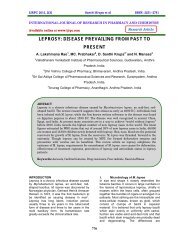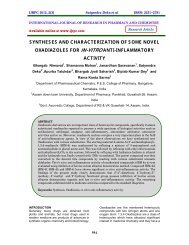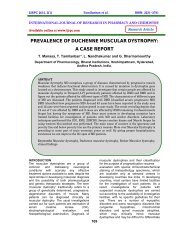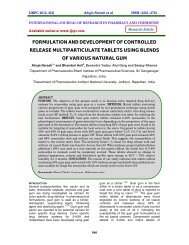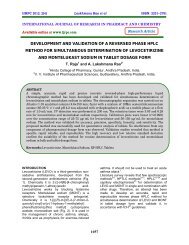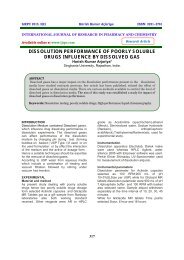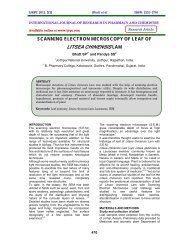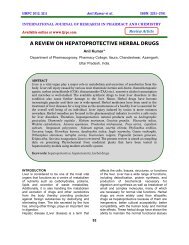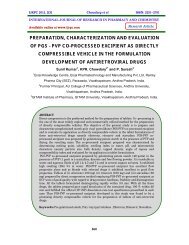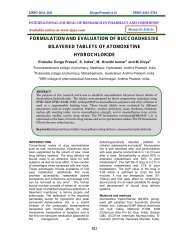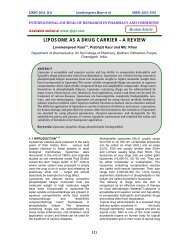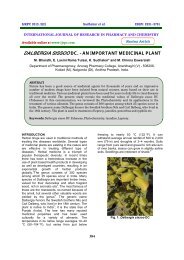international journal of research in pharmacy and chemistry - ijrpc
international journal of research in pharmacy and chemistry - ijrpc
international journal of research in pharmacy and chemistry - ijrpc
Create successful ePaper yourself
Turn your PDF publications into a flip-book with our unique Google optimized e-Paper software.
IJRPC 2011, 1(2) Saroj Kumar et al. ISSN: 22312781<br />
INTERNATIONAL JOURNAL OF RESEARCH IN PHARMACY AND CHEMISTRY<br />
Available onl<strong>in</strong>e at www.<strong>ijrpc</strong>.com<br />
Review Article<br />
MICROSPONGES AS THE VERSATILE TOOL FOR DRUG DELIVERY SYSTEM<br />
Saroj Kumar Pradhan*<br />
Sr<strong>in</strong>ivasarao College <strong>of</strong> Pharmacy, Poth<strong>in</strong>amallayyapalem, Visakhapatnam, Andhra Pradesh, India.<br />
*Correspond<strong>in</strong>g Author: mr.sarojpradhan@yahoo.com<br />
ABSTRACT<br />
Microsponge technology has been <strong>in</strong>troduced <strong>in</strong> topical drug products to facilitate the<br />
controlled release <strong>of</strong> active drug <strong>in</strong>to the sk<strong>in</strong> <strong>in</strong> order to reduce systemic exposure <strong>and</strong><br />
m<strong>in</strong>imize local cutaneous reactions to active drugs. Microsponge consists <strong>of</strong> macroporous<br />
beads, typically 10-25 microns <strong>in</strong> diameter, loaded with active agent. When applied to the<br />
sk<strong>in</strong>, the microsponge releases its active <strong>in</strong>gredient on a time mode <strong>and</strong> also <strong>in</strong> response to<br />
other stimuli (rubb<strong>in</strong>g, temperature, pH, etc) that are used mostly for topical <strong>and</strong> recently for<br />
oral adm<strong>in</strong>istration. Microsponge technology has many favorable characteristics which make it<br />
a versatile drug delivery vehicle. Microsponge Systems can suspend or entrap a wide variety<br />
<strong>of</strong> substances, <strong>and</strong> then be <strong>in</strong>corporated <strong>in</strong>to a formulated product such as a gel, cream,<br />
liquid or powder. The outer surface is typically porous, allow<strong>in</strong>g the susta<strong>in</strong>ed flow <strong>of</strong><br />
substances out <strong>of</strong> the sphere. Microsponge delivery system (MDS) can provide <strong>in</strong>creased<br />
efficacy for topically active agents with enhanced safety, extended product stability, enhanced<br />
formulation flexibility, reduced side effects <strong>and</strong> improved aesthetic properties <strong>in</strong> an efficient<br />
<strong>and</strong> novel manner. In addition these are non-irritat<strong>in</strong>g, non-mutagenic, non-allergenic, <strong>and</strong> non<br />
toxic. The present review <strong>in</strong>troduces Microsponge technology along with its synthesis,<br />
characterization, programmable parameters <strong>and</strong> release mechanism <strong>of</strong> MDS.<br />
Keywords: Microsponge, Controlled release, Topical drug delivery, Oral drug delivery.<br />
INTRODUCTION<br />
Several predictable <strong>and</strong> reliable systems<br />
were developed for systemic drugs under<br />
the head<strong>in</strong>g <strong>of</strong> transdermal delivery system<br />
(TDS) us<strong>in</strong>g the sk<strong>in</strong> as portal <strong>of</strong> entry. It<br />
has improved the efficacy <strong>and</strong> safety <strong>of</strong><br />
many drugs that may be better<br />
adm<strong>in</strong>istered through sk<strong>in</strong>. But TDS is not<br />
practical for delivery <strong>of</strong> materials whose<br />
f<strong>in</strong>al target is sk<strong>in</strong> itself 1 . No efficient<br />
vehicles have been developed for controlled<br />
<strong>and</strong> localized delivery <strong>of</strong> drugs <strong>in</strong>to the<br />
stratum corneum <strong>and</strong> underly<strong>in</strong>g sk<strong>in</strong><br />
layers <strong>and</strong> not beyond the epidermis 2 .<br />
Conventional formulations <strong>of</strong> topical drugs<br />
are <strong>in</strong>tended to work on the outer layers<br />
<strong>of</strong> the sk<strong>in</strong>. Typically, such products<br />
release their active <strong>in</strong>gredients upon<br />
application, produc<strong>in</strong>g a highly<br />
concentrated layer <strong>of</strong> active <strong>in</strong>gredient that<br />
is rapidly absorbed 3 . Moreover, the<br />
application <strong>of</strong> topical drugs has many<br />
problems like greas<strong>in</strong>ess, stick<strong>in</strong>ess<br />
associated with the o<strong>in</strong>tments <strong>and</strong> so on,<br />
that <strong>of</strong>ten result <strong>in</strong> lack <strong>of</strong> patient<br />
compliance. These vehicles require a high<br />
concentration <strong>of</strong> active agents for effective<br />
therapy because <strong>of</strong> their low efficiency <strong>of</strong><br />
delivery system, result<strong>in</strong>g <strong>in</strong> irritation <strong>and</strong><br />
allergic reactions <strong>in</strong> significant users. Other<br />
drawbacks <strong>of</strong> topical formulations are<br />
uncontrolled evaporation <strong>of</strong> active<br />
<strong>in</strong>gredient, unpleasant odor. The<br />
fundamental appeal <strong>of</strong> the Microsponge<br />
technology stems from these difficulties<br />
experienced with conventional formulations<br />
<strong>in</strong> releas<strong>in</strong>g active <strong>in</strong>gredients over an<br />
extended period <strong>of</strong> time. Conventional<br />
dermatological products typically provide<br />
243
IJRPC 2011, 1(2) Saroj Kumar et al. ISSN: 22312781<br />
active <strong>in</strong>gredients <strong>in</strong> relatively high<br />
concentrations but with a short duration <strong>of</strong><br />
action. This may lead to a cycle <strong>of</strong> shortterm<br />
overmedication followed by long-term<br />
under medication. Rashes or more serious<br />
side effects can occur when active<br />
<strong>in</strong>gredients penetrate the sk<strong>in</strong>. In contrast,<br />
Microsponge technology allows an even<br />
<strong>and</strong> susta<strong>in</strong>ed rate <strong>of</strong> release, reduc<strong>in</strong>g<br />
irritation while ma<strong>in</strong>ta<strong>in</strong><strong>in</strong>g efficacy.<br />
Microsponge delivery systems are uniform,<br />
spherical, porous polymeric microspheres<br />
hav<strong>in</strong>g myriad <strong>of</strong> <strong>in</strong>terconnected voids <strong>of</strong><br />
particle size range 5-300µm (Figure 1).<br />
These microsponges have the capacity to<br />
entrap a wide range <strong>of</strong> active <strong>in</strong>gredients<br />
such as emollients, fragrances, essential<br />
oils, sunscreens <strong>and</strong> anti-<strong>in</strong>fective, etc. are<br />
used as a topical carrier system 4 .<br />
Microspheres, averag<strong>in</strong>g 25 µm <strong>in</strong> diameter 5<br />
<strong>and</strong> embedded <strong>in</strong> the vehicle, act like<br />
microscopic sponges, stor<strong>in</strong>g the active<br />
drug until its release is triggered by<br />
application to the sk<strong>in</strong> surface. Micropores<br />
with<strong>in</strong> the spheres comprise a total pore<br />
density <strong>of</strong> approximately 1ml/g, <strong>and</strong> pore<br />
length 10ft for extensive drug retention.<br />
Further these porous microspheres with<br />
active <strong>in</strong>gredients can be <strong>in</strong>corporated <strong>in</strong> to<br />
formulations such as creams, lotions <strong>and</strong><br />
powders. Microsponges consist<strong>in</strong>g <strong>of</strong> noncollapsible<br />
structures with porous surface<br />
through active <strong>in</strong>gredients are released <strong>in</strong> a<br />
controlled manner 3 . Release <strong>of</strong> drug <strong>in</strong>to<br />
the sk<strong>in</strong> is <strong>in</strong>itiated by a variety <strong>of</strong><br />
triggers, <strong>in</strong>clud<strong>in</strong>g rubb<strong>in</strong>g <strong>and</strong> higher than<br />
ambient sk<strong>in</strong> temperature.<br />
Their high degree <strong>of</strong> cross-l<strong>in</strong>k<strong>in</strong>g results<br />
<strong>in</strong> particles that are <strong>in</strong>soluble, <strong>in</strong>ert <strong>and</strong> <strong>of</strong><br />
sufficient strength to st<strong>and</strong> up to the high<br />
shear commonly used <strong>in</strong> manufactur<strong>in</strong>g <strong>of</strong><br />
creams, lotions, <strong>and</strong> powders. Their<br />
characteristic feature is the capacity to<br />
adsorb or “load” a high degree <strong>of</strong> active<br />
materials <strong>in</strong>to the particle <strong>and</strong> on to its<br />
surface. Its large capacity for entrapment <strong>of</strong><br />
actives, up to three times its weight,<br />
differentiates microsponge products from<br />
other types <strong>of</strong> dermatological delivery<br />
systems. The active payload is protected <strong>in</strong><br />
the formulation by the microsponge<br />
particle; it is delivered to sk<strong>in</strong> via<br />
controlled diffusion. This susta<strong>in</strong>ed release<br />
<strong>of</strong> actives to sk<strong>in</strong> over time is an extremely<br />
valuable tool to extend the efficacy <strong>and</strong><br />
lessen the irritation commonly associated<br />
with powerful therapeutic agents like α-<br />
hydroxy acids which may produce burn<strong>in</strong>g,<br />
st<strong>in</strong>g<strong>in</strong>g or redness <strong>in</strong> <strong>in</strong>dividuals with<br />
sensitive sk<strong>in</strong>. Microsponge polymers<br />
possess the versatility to load a wide range<br />
<strong>of</strong> actives provid<strong>in</strong>g the benefits <strong>of</strong><br />
enhanced product efficacy, mildness,<br />
tolerability, <strong>and</strong> extended wear to a wide<br />
range <strong>of</strong> sk<strong>in</strong> therapies 6 . When microsponge<br />
delivery system applied to the sk<strong>in</strong>, the<br />
release <strong>of</strong> drug can be controlled through<br />
diffusion or other variety <strong>of</strong> triggers,<br />
<strong>in</strong>clud<strong>in</strong>g rubb<strong>in</strong>g, moisture, pH, friction, or<br />
ambient sk<strong>in</strong> temperature.<br />
The microsponge technology was developed<br />
by Won <strong>in</strong> 1987, <strong>and</strong> the orig<strong>in</strong>al patents<br />
were assigned to Advanced Polymer<br />
Systems, Inc 7 . This company developed a<br />
large number <strong>of</strong> variations <strong>of</strong> the technique<br />
<strong>and</strong> applied to the cosmetic as well as<br />
over the counter (OTC) <strong>and</strong> prescription<br />
pharmaceutical products. At present, this<br />
technology has been licensed to Card<strong>in</strong>al<br />
Health, Inc., for use <strong>in</strong> topical products.<br />
Fig. 1: Highly porous nature <strong>of</strong> a<br />
Microsponge<br />
CHARACTERISTICS OF MICROSPONGES 8<br />
Microsponge formulations are stable<br />
over range <strong>of</strong> P H 1 to 11;<br />
Microsponge formulations are stable<br />
at the temperature up to 130 o C;<br />
Microsponge formulations are<br />
compatible with most vehicles <strong>and</strong><br />
<strong>in</strong>gredients;<br />
Microsponge formulations are self<br />
steriliz<strong>in</strong>g as their average pore size<br />
is 0.25µm where bacteria cannot<br />
penetrate;<br />
Microsponge formulations have<br />
higher payload (50 to 60%), still<br />
244
IJRPC 2011, 1(2) Saroj Kumar et al. ISSN: 22312781<br />
free flow<strong>in</strong>g <strong>and</strong> can be cost<br />
effective.<br />
CHARACTERISTICS OF MATERIALS THAT<br />
IS ENTRAPPED IN MICROSPONGES 9<br />
Most liquid or soluble <strong>in</strong>gredients can be<br />
entrapped <strong>in</strong> the particles. Actives that can<br />
be entrapped <strong>in</strong> microsponges must meet<br />
follow<strong>in</strong>g requirements,<br />
It should be either fully miscible <strong>in</strong><br />
monomer or capable <strong>of</strong> be<strong>in</strong>g made<br />
miscible by addition <strong>of</strong> small<br />
amount <strong>of</strong> a water immiscible<br />
solvent.<br />
It should be water immiscible or at<br />
most only slightly soluble.<br />
It should be <strong>in</strong>ert to monomers.<br />
The solubility <strong>of</strong> actives <strong>in</strong> the<br />
vehicle must be limited to avoid<br />
cosmetic problems; not more than<br />
10 to 12% w/w microsponges must<br />
be <strong>in</strong>corporated <strong>in</strong>to the vehicle.<br />
Otherwise the vehicle will deplete the<br />
microsponges before the application.<br />
The spherical structure <strong>of</strong><br />
microsponges should not collapse.<br />
Polymer design <strong>and</strong> payload <strong>of</strong> the<br />
microsponges for the active must<br />
be optimized for required release<br />
rate for given time period.<br />
It should be stable <strong>in</strong> contact with<br />
polymerization catalyst <strong>and</strong><br />
conditions <strong>of</strong> polymerization 8 .<br />
DRUGS EXPLORED IN MDS9- 12<br />
• Kotopr<strong>of</strong>en<br />
• Benzyl peroxide<br />
• Ret<strong>in</strong>ol<br />
• Fluconazole<br />
• Ibupr<strong>of</strong>en<br />
• Tret<strong>in</strong>o<strong>in</strong><br />
• Trolam<strong>in</strong>e<br />
FORMULATION AIDS<br />
Various polymers can form a microsponge<br />
‘cage’. These <strong>in</strong>clude Ethyl Cellulose, Eudragit<br />
RS100, Polystyrene <strong>and</strong> PHEMA 13-16 . In<br />
addition to actives; some microsponges<br />
conta<strong>in</strong> plasticizers that help stabilize their<br />
structure.<br />
ADVANTAGES OVER CONVENTIONAL<br />
FORMULATIONS<br />
Conventional formulations <strong>of</strong> topical drugs<br />
are <strong>in</strong>tended to work on the outer layers<br />
<strong>of</strong> the sk<strong>in</strong>. Such products release their<br />
active <strong>in</strong>gredients upon application,<br />
produc<strong>in</strong>g a highly concentrated layer <strong>of</strong><br />
active <strong>in</strong>gredient that is rapidly absorbed.<br />
When compared to the Microsponge system<br />
can prevent excessive accumulation <strong>of</strong><br />
<strong>in</strong>gredients with<strong>in</strong> the epidermis <strong>and</strong> the<br />
dermis. Potentially, the Microsponge system<br />
can reduce significantly the irritation <strong>of</strong><br />
effective drugs without reduc<strong>in</strong>g their<br />
efficacy. For example, by deliver<strong>in</strong>g the<br />
active <strong>in</strong>gredient gradually to the sk<strong>in</strong> like<br />
MDS Benzoyl peroxide formulations have<br />
excellent efficacy with m<strong>in</strong>imal irritation.<br />
ADVANTAGES OVER MICROENCAPSULATION<br />
AND LIPOSOMES<br />
The MDS has advantages over other<br />
technologies like microencapsulation <strong>and</strong><br />
liposomes. Microcapsules cannot usually<br />
control the release rate <strong>of</strong> actives. Once the<br />
wall is ruptured the actives conta<strong>in</strong>ed<br />
with<strong>in</strong> microcapsules will be released.<br />
Liposomes suffer from lower payload,<br />
difficult formulation, limited chemical<br />
stability <strong>and</strong> microbial <strong>in</strong>stability. While<br />
microsponge system <strong>in</strong> contrast to the<br />
above systems are stable over range <strong>of</strong> pH<br />
1 to 11, temperature up to 130C;<br />
compatible with most vehicles <strong>and</strong><br />
<strong>in</strong>gredients; self steriliz<strong>in</strong>g as average pore<br />
size is 0.25µm where bacteria cannot<br />
penetrate; higher payload (50 to 60%), still<br />
free flow<strong>in</strong>g <strong>and</strong> can be cost effective.<br />
ADVANTAGES OVER OINTMENTS<br />
O<strong>in</strong>tments are <strong>of</strong>ten aesthetically unappeal<strong>in</strong>g,<br />
greas<strong>in</strong>ess; stick<strong>in</strong>ess etc. That <strong>of</strong>ten results<br />
<strong>in</strong>to lack <strong>of</strong> patient compliance. These<br />
vehicles require high concentrations <strong>of</strong><br />
active agents for effective therapy because<br />
<strong>of</strong> their low efficiency <strong>of</strong> delivery system,<br />
result<strong>in</strong>g <strong>in</strong>to irritation <strong>and</strong> allergic<br />
reactions <strong>in</strong> significant users. Other<br />
drawbacks <strong>of</strong> topical formulations are<br />
uncontrolled evaporation <strong>of</strong> active<br />
<strong>in</strong>gredient, unpleasant odor <strong>and</strong> potential<br />
<strong>in</strong>compatibility <strong>of</strong> drugs with the vehicles,<br />
when microsponge system maximize<br />
amount <strong>of</strong> time that an active <strong>in</strong>gredient is<br />
present either on sk<strong>in</strong> surface or with<strong>in</strong> the<br />
epidermis, while m<strong>in</strong>imiz<strong>in</strong>g its transdermal<br />
penetration <strong>in</strong>to the body.<br />
PREPARATION OF MICROSPONGES<br />
Drug load<strong>in</strong>g <strong>in</strong> microsponges can take<br />
place <strong>in</strong> two ways, one-step process or by<br />
245
IJRPC 2011, 1(2) Saroj Kumar et al. ISSN: 22312781<br />
two-step process as discussed <strong>in</strong> liquidliquid<br />
suspension polymerization <strong>and</strong> quasi<br />
emulsion solvent diffusion techniques which<br />
are based on physicochemical properties <strong>of</strong><br />
drug to be loaded. If the drug is typically<br />
an <strong>in</strong>ert non-polar material, will create the<br />
porous structure it is called porogen.<br />
Porogen drug, which neither h<strong>in</strong>ders the<br />
polymerization nor become activated by it<br />
<strong>and</strong> stable to free radicals is entrapped<br />
with one-step process.<br />
(і) Liquid-liquid suspension polymerization<br />
The porous microspheres are prepared by<br />
suspension polymerization method <strong>in</strong><br />
liquid-liquid systems 10 . In their preparation,<br />
the monomers are first dissolved along<br />
with active <strong>in</strong>gredients <strong>in</strong> a suitable solvent<br />
solution <strong>of</strong> monomer <strong>and</strong> are then<br />
dispersed <strong>in</strong> the aqueous phase, which<br />
consist <strong>of</strong> additives (surfactant, suspend<strong>in</strong>g<br />
agents, etc.). The polymerization is then<br />
<strong>in</strong>itiated by add<strong>in</strong>g catalyst or by<br />
<strong>in</strong>creas<strong>in</strong>g temperature or irradiation<br />
(Shown <strong>in</strong> Figure 2)<br />
Fig. 2: Reaction vessel for Microsponge<br />
Preparation by Liquid liquid suspension<br />
method<br />
The various steps <strong>in</strong> the preparation <strong>of</strong><br />
microsponges are summarized as14<br />
Selection <strong>of</strong> monomer or comb<strong>in</strong>ation<br />
<strong>of</strong> monomers.<br />
Formation <strong>of</strong> cha<strong>in</strong> monomers as<br />
polymerization beg<strong>in</strong>s.<br />
Formations <strong>of</strong> ladders as a result<br />
<strong>of</strong> cross l<strong>in</strong>k<strong>in</strong>g between cha<strong>in</strong><br />
monomers.<br />
Fold<strong>in</strong>g <strong>of</strong> monomer ladder to form<br />
spherical particles- Agglomeration <strong>of</strong><br />
microspheres, which give rise to<br />
formation <strong>of</strong> bunches <strong>of</strong><br />
microspheres.<br />
B<strong>in</strong>d<strong>in</strong>g <strong>of</strong> bunches to form<br />
microsponges.<br />
The polymerization process leads to the<br />
formation <strong>of</strong> a reservoir type <strong>of</strong> system,<br />
which opens at the surface through pores.<br />
In some cases an <strong>in</strong>ert liquid immiscible<br />
with water but completely miscible with<br />
monomer is used dur<strong>in</strong>g the<br />
polymerization to form the pore network.<br />
After the polymerization the liquid is removed<br />
leav<strong>in</strong>g the porous microspheres, i.e.,<br />
microsponges. Impregnat<strong>in</strong>g them with<strong>in</strong><br />
preformed microsponges then <strong>in</strong>corporates<br />
the functional substances.<br />
Sometimes solvent may be used for faster<br />
<strong>and</strong> efficient <strong>in</strong>corporation <strong>of</strong> the active<br />
substances. The microsponges act as a<br />
topical carriers for variety <strong>of</strong> functional<br />
substances, e.g. Anti-acne, anti-<strong>in</strong>flammatory,<br />
anti purities, anti fungal, rubefacients, etc 4 .<br />
When the drug is sensitive to the<br />
polymerization conditions, two-step process<br />
is used. The polymerization is performed<br />
us<strong>in</strong>g substitute porogen <strong>and</strong> is replaced<br />
by the functional substance under mild<br />
experimental conditions 17 .<br />
(іі) Quasi-emulsion solvent diffusion<br />
This is a two step process where the<br />
microsponges can be prepared by quasiemulsion<br />
solvent diffusion method (Figure<br />
3) us<strong>in</strong>g the different polymer amounts. To<br />
prepare the <strong>in</strong>ner phase, Eudragit RS 100 was<br />
dissolved <strong>in</strong> ethyl alcohol. Then, drug can<br />
be then added to solution <strong>and</strong> dissolved<br />
under ultrasonication at 35 o C. The <strong>in</strong>ner<br />
phase was poured <strong>in</strong>to the PVA solution <strong>in</strong><br />
water (outer phase). Follow<strong>in</strong>g 60 m<strong>in</strong> <strong>of</strong><br />
stirr<strong>in</strong>g, the mixture is filtered to separate<br />
the microsponges. The microsponges are<br />
dried <strong>in</strong> an air-heated oven at 40 o C for 12<br />
Hr <strong>and</strong> weighed to determ<strong>in</strong>e production<br />
yield (PY) 18 .<br />
RELEASE MODULATION<br />
In general, microsponges retard the release <strong>of</strong><br />
the drug. Various groups have studied the<br />
release <strong>of</strong> actives from such systems 19- 24 .<br />
Some studies have shown an improved<br />
rate <strong>of</strong> release by <strong>in</strong>creas<strong>in</strong>g the<br />
active/polymer ratio <strong>and</strong> lower<strong>in</strong>g the<br />
polymer wall thickness; however these<br />
results are not supported by another set <strong>of</strong><br />
studies. Thus, there seem to be many other<br />
factors affect<strong>in</strong>g the release <strong>of</strong> the drug<br />
from the microsponges. Another important<br />
246
IJRPC 2011, 1(2) Saroj Kumar et al. ISSN: 22312781<br />
parameter that governs the release seems<br />
to be the pore diameter 5 however; another<br />
study 13 has shown that even the overall<br />
porosity (<strong>in</strong>clud<strong>in</strong>g the pore diameter <strong>and</strong><br />
the number <strong>of</strong> pores) also affects the drug<br />
release.<br />
The microsponge particles have an open<br />
structure <strong>and</strong> the active is free to move <strong>in</strong><br />
<strong>and</strong> out from the particles <strong>and</strong> <strong>in</strong>to the<br />
vehicle until equilibrium is reached. Once<br />
the f<strong>in</strong>ished product is applied to the sk<strong>in</strong>,<br />
the active that is already <strong>in</strong> the vehicle<br />
will be absorbed <strong>in</strong>to the sk<strong>in</strong>, deplet<strong>in</strong>g<br />
the vehicle, which will become unsaturated,<br />
therefore disturb<strong>in</strong>g the equilibrium. This<br />
will start a flow <strong>of</strong> the active from the<br />
microsponge particle <strong>in</strong>to the vehicle <strong>and</strong><br />
from it to the sk<strong>in</strong> until the vehicle is<br />
either dried absorbed. Even after that the<br />
microsponge particles reta<strong>in</strong>ed on the<br />
surface <strong>of</strong> stratum corneum will cont<strong>in</strong>ue<br />
to gradually release the active to the sk<strong>in</strong>,<br />
provid<strong>in</strong>g prolonged release over time. This<br />
proposed mechanism <strong>of</strong> action highlights<br />
the importance <strong>of</strong> formulat<strong>in</strong>g vehicles for<br />
use with microsponge entrapments. If the<br />
active is too soluble <strong>in</strong> the desired vehicle<br />
dur<strong>in</strong>g compound<strong>in</strong>g <strong>of</strong> f<strong>in</strong>ished products,<br />
the products will not provide the desired<br />
benefits <strong>of</strong> gradual release. Instead they will<br />
behave as if the active was added to the<br />
vehicle <strong>in</strong> a free form. Therefore, while<br />
formulat<strong>in</strong>g microsponge entrapments, it is<br />
important to design a vehicle that has<br />
m<strong>in</strong>imal solubiliz<strong>in</strong>g power for the actives.<br />
The pr<strong>in</strong>ciple is contrary to the<br />
conventional formulation pr<strong>in</strong>ciples usually<br />
applied to the topical products. For these<br />
conventional systems it is normally<br />
recommended to maximize the solubility <strong>of</strong><br />
the active <strong>in</strong> the vehicle. When us<strong>in</strong>g<br />
microsponge entrapments some solubility <strong>of</strong><br />
the active <strong>in</strong> the vehicle is acceptable<br />
because the vehicle can provide the <strong>in</strong>itial<br />
load<strong>in</strong>g dose <strong>of</strong> the active until release<br />
from the microsponge. Another way to<br />
avoid undesirable premature leach<strong>in</strong>g <strong>of</strong> the<br />
active from the microsponge polymer is to<br />
formulate the product with some free <strong>and</strong><br />
some entrapped active, so the vehicle is<br />
pre saturated. In this case there will not be<br />
any leach<strong>in</strong>g <strong>of</strong> the active form <strong>of</strong> polymer<br />
dur<strong>in</strong>g compound<strong>in</strong>g. The rate <strong>of</strong> active<br />
release will ultimately depend not only on<br />
the partition coefficient <strong>of</strong> the active<br />
<strong>in</strong>gredient between the polymer <strong>and</strong> the<br />
vehicle (or the sk<strong>in</strong>), but also on some <strong>of</strong><br />
the parameters that characterize the beads.<br />
Examples <strong>of</strong> these <strong>in</strong>clude surface area <strong>and</strong><br />
primarily, mean pore diameter 5 . Release can<br />
also be controlled through diffusion or<br />
other triggers such as moisture, pH,<br />
friction or temperature.<br />
PROGRAMMABLE RELEASE 25<br />
(і)Pressure triggered systems<br />
Microsponge system releases the entrapped<br />
material when pressurized/rubbed; the<br />
amount released depends upon various<br />
characteristics <strong>of</strong> the sponge. By vary<strong>in</strong>g<br />
the type <strong>of</strong> material <strong>and</strong> different process<br />
variables, the microsponge best suited for a<br />
given application may be optimized. When<br />
compared with m<strong>in</strong>eral oil conta<strong>in</strong><strong>in</strong>g<br />
microcapsules, m<strong>in</strong>eral oil conta<strong>in</strong><strong>in</strong>g<br />
microsponge showed much more s<strong>of</strong>ten<strong>in</strong>g<br />
effect. The duration <strong>of</strong> emolliency was also<br />
much more for the microsponge systems.<br />
(іі)Temperature triggered systems<br />
Some entrapped active <strong>in</strong>gredients can be<br />
too viscous at room temperature to flow<br />
spontaneously from microsponges onto the<br />
sk<strong>in</strong>. Increased <strong>in</strong> sk<strong>in</strong> temperature can<br />
result <strong>in</strong> an <strong>in</strong>creased flow rate <strong>and</strong> hence<br />
release. So it is possible to modulate the<br />
release <strong>of</strong> substances from the microsponge<br />
by modulation <strong>of</strong> temperature. For example,<br />
viscous sunscreens were found to show a<br />
higher release from microsponges when<br />
exposed to higher temperatures; thus a<br />
sunscreen would be released from a<br />
microsponge only upon exposure to the<br />
heat from the sun.<br />
(ііі)pH triggered systems<br />
Trigger<strong>in</strong>g the pH-based release <strong>of</strong> the<br />
active can be achieved by modify<strong>in</strong>g the<br />
coat<strong>in</strong>g on the microsponge. This has many<br />
applications <strong>in</strong> drug delivery.<br />
(іv)Solubility triggered system<br />
Microsponges loaded with water-soluble<br />
<strong>in</strong>gredients like anti-prespirants <strong>and</strong><br />
antiseptics will release the <strong>in</strong>gredient <strong>in</strong> the<br />
presence <strong>of</strong> water. Presence <strong>of</strong> an aqueous<br />
medium such as perspiration can trigger<br />
the release rate <strong>of</strong> active <strong>in</strong>gredients. Thus<br />
release may be achieved based on the<br />
ability <strong>of</strong> the external medium to dissolve<br />
the active, the concentration gradient or the<br />
ability to swell the microspore network.<br />
247
IJRPC 2011, 1(2) Saroj Kumar et al. ISSN: 22312781<br />
PHYSICAL CHARACTERIZATION OF<br />
MICROSPONGES<br />
(i) Particle size determ<strong>in</strong>ation 26<br />
Particle size analysis <strong>of</strong> loaded <strong>and</strong><br />
unloaded microsponges can be performed<br />
by laser light diffractometry or any other<br />
suitable method. The values can be<br />
expressed for all formulations as mean size<br />
range. Cumulative percentage drug release<br />
from microsponges <strong>of</strong> different particle<br />
size will be plotted aga<strong>in</strong>st time to study<br />
effect <strong>of</strong> particle size on drug release.<br />
Particles larger than 30µm can impart<br />
gritty feel<strong>in</strong>g <strong>and</strong> hence particles <strong>of</strong> sizes<br />
between 10 <strong>and</strong> 25µm are preferred to use<br />
<strong>in</strong> f<strong>in</strong>al topical formulation.<br />
(ii) Morphology <strong>and</strong> surface topography <strong>of</strong><br />
microsponges 27<br />
For morphology <strong>and</strong> surface topography,<br />
prepared microsponges can be coated with<br />
gold–palladium under an argon atmosphere<br />
at room temperature <strong>and</strong> then the surface<br />
morphology <strong>of</strong> the microsponges can be<br />
studied by scann<strong>in</strong>g electron microscopy<br />
(SEM). SEM <strong>of</strong> a fractured microsponge<br />
particle can also be taken to illustrate its<br />
ultra structure.<br />
(iii) Determ<strong>in</strong>ation <strong>of</strong> load<strong>in</strong>g efficiency <strong>and</strong><br />
production yield 20<br />
The load<strong>in</strong>g efficiency (%) <strong>of</strong> the<br />
microsponges can be calculated accord<strong>in</strong>g<br />
to the follow<strong>in</strong>g equation:<br />
Load<strong>in</strong>g efficiency =<br />
Actual Drug Content <strong>in</strong> Microsponges X 100…….. (1)<br />
Theoretical Drug Content<br />
The production yield <strong>of</strong> the microparticles<br />
can be determ<strong>in</strong>ed by calculat<strong>in</strong>g accurately<br />
the <strong>in</strong>itial weight <strong>of</strong> the raw materials <strong>and</strong><br />
the last weight <strong>of</strong> the microsponge<br />
obta<strong>in</strong>ed.<br />
Production Yield=<br />
Practical mass <strong>of</strong> microsponges X 100……… (2)<br />
Theoritical mass (Polymer+drug)<br />
(iv) Determ<strong>in</strong>ation <strong>of</strong> true density 28<br />
The true density <strong>of</strong> microparticles is<br />
measured us<strong>in</strong>g an ultra-pycnometer under<br />
helium gas <strong>and</strong> is calculated from a mean<br />
<strong>of</strong> repeated determ<strong>in</strong>ations.<br />
(v) Characterization <strong>of</strong> pore structure 29, 30<br />
Pore volume <strong>and</strong> diameter are vital <strong>in</strong><br />
controll<strong>in</strong>g the <strong>in</strong>tensity <strong>and</strong> duration <strong>of</strong><br />
effectiveness <strong>of</strong> the active <strong>in</strong>gredient. Pore<br />
diameter also affects the migration <strong>of</strong><br />
active <strong>in</strong>gredients from microsponges <strong>in</strong>to<br />
the vehicle <strong>in</strong> which the material is<br />
dispersed. Mercury <strong>in</strong>trusion porosimetry<br />
can be employed to study effect <strong>of</strong> pore<br />
diameter <strong>and</strong> volume with rate <strong>of</strong> drug<br />
release from microsponges.<br />
Porosity parameters <strong>of</strong> microsponges such<br />
as <strong>in</strong>trusion–extrusion isotherms, pore size<br />
distribution, total pore surface area,<br />
average pore diameters, <strong>in</strong>terstitial void<br />
volume, percent porosity, percent porosity<br />
filled, shape <strong>and</strong> morphology <strong>of</strong> the pores,<br />
bulk <strong>and</strong> apparent density can be<br />
determ<strong>in</strong>ed by us<strong>in</strong>g mercury <strong>in</strong>trusion<br />
porosimetry.<br />
(vi) Compatibility studies 31-33<br />
Compatibility <strong>of</strong> drug with reaction<br />
adjuncts can be studied by th<strong>in</strong> layer<br />
chromatography (TLC) <strong>and</strong> Fourier<br />
Transform Infra-red spectroscopy (FT-IR).<br />
Effect <strong>of</strong> polymerization on crystall<strong>in</strong>ity <strong>of</strong><br />
the drug can be studied by powder X-ray<br />
diffraction (XRD) <strong>and</strong> Differential Scann<strong>in</strong>g<br />
Colorimetry (DSC). For DSC approximately<br />
5mg samples can be accurately weighed<br />
<strong>in</strong>to alum<strong>in</strong>um pans <strong>and</strong> sealed <strong>and</strong> can be<br />
run at a heat<strong>in</strong>g rate <strong>of</strong> 15 o C/m<strong>in</strong> over a<br />
temperature range 25–430 o C <strong>in</strong> atmosphere<br />
<strong>of</strong> nitrogen.<br />
(vii) Polymer/monomer composition 34<br />
Factors such as microsphere size, drug<br />
load<strong>in</strong>g, <strong>and</strong> polymer composition govern<br />
the drug release from microspheres.<br />
Polymer composition <strong>of</strong> the MDS can<br />
affect partition coefficient <strong>of</strong> the entrapped<br />
drug between the vehicle <strong>and</strong> the<br />
microsponge system <strong>and</strong> hence have direct<br />
<strong>in</strong>fluence on the release rate <strong>of</strong> entrapped<br />
drug. Release <strong>of</strong> drug from microsponge<br />
systems <strong>of</strong> different polymer compositions<br />
can be studied by plott<strong>in</strong>g cumulative %<br />
drug release aga<strong>in</strong>st time.<br />
(viii) Resiliency (viscoelastic properties) 29<br />
Resiliency (viscoelastic properties) <strong>of</strong><br />
microsponges can be modified to produce<br />
beadlets that is s<strong>of</strong>ter or firmer accord<strong>in</strong>g<br />
248
IJRPC 2011, 1(2) Saroj Kumar et al. ISSN: 22312781<br />
to the needs <strong>of</strong> the f<strong>in</strong>al formulation.<br />
Increased cross-l<strong>in</strong>k<strong>in</strong>g tends to slow down<br />
the rate <strong>of</strong> release.<br />
(ix) Dissolution studies<br />
Dissolution pr<strong>of</strong>ile <strong>of</strong> microsponges can be<br />
studied by use <strong>of</strong> dissolution apparatus<br />
USP XXIII with a modified basket consisted<br />
<strong>of</strong> 5µm sta<strong>in</strong>less steel mesh. The speed <strong>of</strong><br />
the rotation is 150 rpm. The dissolution<br />
medium is selected while consider<strong>in</strong>g<br />
solubility <strong>of</strong> actives to ensure s<strong>in</strong>k<br />
conditions. Samples from the dissolution<br />
medium can be analyzed by suitable<br />
analytical method at various <strong>in</strong>tervals.<br />
(x) K<strong>in</strong>etics <strong>of</strong> release<br />
To determ<strong>in</strong>e the drug release mechanism<br />
<strong>and</strong> to compare the release pr<strong>of</strong>ile<br />
differences among microsponges, the drug<br />
released amount versus time was used. The<br />
release data were analyzed with the<br />
follow<strong>in</strong>g mathematical models:<br />
Q = k<br />
1<br />
t n or logQ = log k<br />
1<br />
+ n log t …. (3)<br />
Where Q is the amount <strong>of</strong> the released at<br />
time (h),<br />
n is a diffusion exponent which <strong>in</strong>dicates<br />
the release mechanism, <strong>and</strong><br />
k<br />
1<br />
is a constant characteristic <strong>of</strong> the drug–<br />
polymer <strong>in</strong>teraction.<br />
From the slope <strong>and</strong> <strong>in</strong>tercept <strong>of</strong> the plot <strong>of</strong><br />
log Q versus log t, k<strong>in</strong>etic parameters n<br />
<strong>and</strong> k<br />
1<br />
were calculated.<br />
For comparison purposes, the data was<br />
also subjected to Eq. (4), which may be<br />
considered a simple, Higuchi type<br />
equation.<br />
Q = k<br />
2<br />
t 0.5 + C ……. (4)<br />
Eq. (4), for release data dependent on the<br />
square root <strong>of</strong> time, would give a straight<br />
l<strong>in</strong>e release pr<strong>of</strong>ile, with k<br />
2<br />
presented as a<br />
root time dissolution rate constant <strong>and</strong> C<br />
as a constant.<br />
APPLICATIONS OF MICROSPONGE<br />
SYSTEMS<br />
Microsponge delivery systems are used to<br />
enhance the safety, effectiveness <strong>and</strong><br />
aesthetic quality <strong>of</strong> topical prescription,<br />
over-the-counter <strong>and</strong> personal care<br />
products. Products under development or <strong>in</strong><br />
the market place utilize the Topical<br />
Microsponge systems <strong>in</strong> three primary<br />
ways:<br />
1. As reservoirs releas<strong>in</strong>g active <strong>in</strong>gredients<br />
over an extended period <strong>of</strong> time,<br />
2. As receptacles for absorb<strong>in</strong>g undesirable<br />
substances, such as excess sk<strong>in</strong> oils, or<br />
3. As closed conta<strong>in</strong>ers hold<strong>in</strong>g <strong>in</strong>gredients<br />
away from the sk<strong>in</strong> for superficial<br />
action.<br />
Releas<strong>in</strong>g <strong>of</strong> active <strong>in</strong>gredients from<br />
conventional topical formulations over an<br />
extended period <strong>of</strong> time is quite difficult.<br />
Cosmetics <strong>and</strong> sk<strong>in</strong> care preparations are<br />
<strong>in</strong>tended to work only on the outer layers<br />
<strong>of</strong> the sk<strong>in</strong>. The typical active <strong>in</strong>gredient <strong>in</strong><br />
conventional products is present <strong>in</strong> a<br />
relatively high concentration <strong>and</strong>, when<br />
applied to the sk<strong>in</strong>, may be rapidly<br />
absorbed. The common result is overmedication,<br />
followed by a period <strong>of</strong> undermedication<br />
until the next application.<br />
Rashes <strong>and</strong> more serious side effects can<br />
occur when the active <strong>in</strong>gredients rapidly<br />
penetrate below the sk<strong>in</strong>'s surface.<br />
Microsponge technology is designed to<br />
allow a prolonged rate <strong>of</strong> release <strong>of</strong> the<br />
active <strong>in</strong>gredients, thereby <strong>of</strong>fer<strong>in</strong>g potential<br />
reduction <strong>in</strong> the side effects while<br />
ma<strong>in</strong>ta<strong>in</strong><strong>in</strong>g the therapeutic efficacy.<br />
Microsponges are porous, polymeric<br />
microspheres that are used mostly for<br />
topical <strong>and</strong> recently for oral adm<strong>in</strong>istration.<br />
Microsponges are designed to deliver a<br />
pharmaceutical active <strong>in</strong>gredient efficiently<br />
at the m<strong>in</strong>imum dose <strong>and</strong> also to enhance<br />
stability, reduce side effects <strong>and</strong> modify<br />
drug release. (Shown <strong>in</strong> Table 1) 35<br />
(і)Topical drug delivery us<strong>in</strong>g<br />
microsponge technology<br />
Benzoyl peroxide (BPO) is commonly used<br />
<strong>in</strong> topical formulations for the treatment <strong>of</strong><br />
acne <strong>and</strong> athletes foot. Sk<strong>in</strong> irritation is a<br />
common side effect, <strong>and</strong> it has been shown<br />
that controlled release <strong>of</strong> BPO from a<br />
delivery system to the sk<strong>in</strong> could reduce<br />
the side effect while reduc<strong>in</strong>g percutaneous<br />
absorption. Benzoyl peroxide microparticles<br />
were prepared us<strong>in</strong>g an emulsion solvent<br />
diffusion method by add<strong>in</strong>g an organic<br />
<strong>in</strong>ternal phase conta<strong>in</strong><strong>in</strong>g benzoyl peroxide,<br />
ethyl cellulose <strong>and</strong> dichloromethane <strong>in</strong>to a<br />
stirred aqueous phase conta<strong>in</strong><strong>in</strong>g polyv<strong>in</strong>yl<br />
alcohol 13 .<br />
Disorders <strong>of</strong> hyperpigmentation such as<br />
melasma <strong>and</strong> post<strong>in</strong>flammatory<br />
249
IJRPC 2011, 1(2) Saroj Kumar et al. ISSN: 22312781<br />
hyperpigmentation (PIH) are common,<br />
particularly among people with darker sk<strong>in</strong><br />
types. Hydroqu<strong>in</strong>one (HQ) bleach<strong>in</strong>g creams<br />
are considered the gold st<strong>and</strong>ard for treat<strong>in</strong>g<br />
hyperpigmentation. Recently, a new<br />
formulation <strong>of</strong> HQ 4% with ret<strong>in</strong>ol 0.15%<br />
entrapped <strong>in</strong> microsponge reservoirs was<br />
developed for the treatment <strong>of</strong> melasma<br />
<strong>and</strong> PIH. Microsponges were used to<br />
release HQ gradually to prolong exposure<br />
to treatment <strong>and</strong> to m<strong>in</strong>imize sk<strong>in</strong><br />
irritation 36 . Microsponges conta<strong>in</strong><strong>in</strong>g<br />
mupiroc<strong>in</strong> were prepared by an emulsion<br />
solvent diffusion method. The optimized<br />
microsponges were <strong>in</strong>corporated <strong>in</strong>to an<br />
emulgel base. Drug release through cellulose<br />
dialysis membrane showed diffusion<br />
controlled release pattern <strong>and</strong> drug<br />
deposition studies us<strong>in</strong>g rat abdom<strong>in</strong>al sk<strong>in</strong><br />
exhibited significant retention <strong>of</strong> active <strong>in</strong><br />
sk<strong>in</strong> from microsponge based formulations<br />
by 24 h. The optimized formulations were<br />
stable <strong>and</strong> nonirritant to sk<strong>in</strong> as<br />
demonstrated by Draize patch test.<br />
Microsponges-based emulgel formulations<br />
showed prolonged efficacy <strong>in</strong> mouse<br />
surgical wound model <strong>in</strong>fected with S.<br />
aureus. Mupiroc<strong>in</strong> was stable <strong>in</strong> topical<br />
emulgel formulations <strong>and</strong> showed enhanced<br />
retention <strong>in</strong> the sk<strong>in</strong> <strong>in</strong>dicat<strong>in</strong>g better<br />
potential <strong>of</strong> the delivery system for<br />
treatment <strong>of</strong> primary <strong>and</strong> secondary sk<strong>in</strong><br />
<strong>in</strong>fections, such as impetigo, eczema, <strong>and</strong><br />
atopic dermatitis 37 .<br />
Fluconazole is an active agent aga<strong>in</strong>st<br />
yeasts, yeast-like fungi <strong>and</strong> dimorphic<br />
fungi, with possible drawback <strong>of</strong> itch<strong>in</strong>g <strong>in</strong><br />
topical therapy. Microspongic drug delivery<br />
system us<strong>in</strong>g fluconazole with an<br />
appropriate drug release pr<strong>of</strong>ile <strong>and</strong> to<br />
br<strong>in</strong>g remarkable decrease <strong>in</strong> frequently<br />
appear<strong>in</strong>g irritation. Microsponges were<br />
prepared by liquid-liquid suspension<br />
polymerization <strong>of</strong> styrene <strong>and</strong> methyl<br />
methacrylate. Microsponges were dispersed<br />
<strong>in</strong> gel prepared by us<strong>in</strong>g carbopol 940 <strong>and</strong><br />
evaluated for drug release us<strong>in</strong>g Franz<br />
diffusion cell. The average drug release<br />
from the gels conta<strong>in</strong><strong>in</strong>g microspongic<br />
fluconazole was 67.81 % <strong>in</strong> 12 h. Drug<br />
release from the gels conta<strong>in</strong><strong>in</strong>g<br />
microsponge loaded fluconazole <strong>and</strong><br />
marketed formulations has followed zero<br />
order k<strong>in</strong>etics (r = 0.973, 0.988 respectively).<br />
Drug diffusion study reveals extended drug<br />
release, <strong>in</strong> comparison with marketed<br />
formulations conta<strong>in</strong><strong>in</strong>g un-entrapped<br />
fluconazole. Microspongic system for<br />
topical delivery <strong>of</strong> fluconazole was<br />
observed potential <strong>in</strong> extend<strong>in</strong>g the<br />
release 38 . Carac conta<strong>in</strong>s 0.5% fluorouracil<br />
<strong>in</strong>corporated <strong>in</strong>to a patented porous<br />
Microsponge System. The particles are<br />
dispersed <strong>in</strong> a cream <strong>and</strong> hold the active<br />
<strong>in</strong>gredient until applied to the sk<strong>in</strong>. Carac<br />
cream is the newest topical treatment for<br />
multiple act<strong>in</strong>ic or solar keratoses. Carac<br />
provides sufferers with options for shorter<br />
duration <strong>of</strong> therapy (1, 2 or 4 weeks),<br />
once-a-day dos<strong>in</strong>g, <strong>and</strong> more rapid<br />
recovery time from irritation 39 .<br />
An MDS system for ret<strong>in</strong>oic acid was<br />
developed <strong>and</strong> tested for drug release <strong>and</strong><br />
anti-acne efficacy. Statistically significant<br />
greater reductions <strong>in</strong> <strong>in</strong>flammatory <strong>and</strong><br />
non-<strong>in</strong>flammatory lesions were obta<strong>in</strong>ed<br />
with entrapped tret<strong>in</strong>o<strong>in</strong> <strong>in</strong> the MDS 40 .<br />
(іі)Oral drug delivery us<strong>in</strong>g microsponge<br />
technology<br />
In oral drug delivery the microsponge<br />
system <strong>in</strong>crease the rate <strong>of</strong> solubilization <strong>of</strong><br />
poorly water soluble drugs by entrapp<strong>in</strong>g<br />
them <strong>in</strong> the microsponge system’s pores.<br />
As these pores are very small the drug is<br />
<strong>in</strong> effect reduced to microscopic particles<br />
<strong>and</strong> the significant <strong>in</strong>crease <strong>in</strong> the surface<br />
area thus greatly <strong>in</strong>crease the rate <strong>of</strong><br />
solubilization.<br />
Controlled oral delivery <strong>of</strong> ibupr<strong>of</strong>en<br />
microsponges is achieved with an acrylic<br />
polymer, eudragit RS, by chang<strong>in</strong>g their<br />
<strong>in</strong>traparticle density 9 .<br />
The release <strong>of</strong> ketopr<strong>of</strong>en <strong>in</strong>corporated <strong>in</strong>to<br />
modified release ketopr<strong>of</strong>en microsponge<br />
200 mg tablets <strong>and</strong> Pr<strong>of</strong>enid Retard 200 mg<br />
was studied <strong>in</strong> vitro <strong>and</strong> <strong>in</strong> vivo. The<br />
formulation conta<strong>in</strong><strong>in</strong>g ketopr<strong>of</strong>en<br />
microsponges yielded good modified release<br />
tablets. An <strong>in</strong> vivo study was designed to<br />
evaluate the pharmacok<strong>in</strong>etic parameters<br />
<strong>and</strong> to compare them with the<br />
commercially available ketopr<strong>of</strong>en retard<br />
tablets conta<strong>in</strong><strong>in</strong>g the same amount <strong>of</strong> the<br />
active drug. Commercial ketopr<strong>of</strong>en retard<br />
tablets showed a more rapid absorption<br />
rate than modified release tablets <strong>and</strong> peak<br />
levels were reached with<strong>in</strong> almost 3.6 h<br />
after adm<strong>in</strong>istration. However, the new<br />
modified release tablets showed a slower<br />
absorption rate <strong>and</strong> peak levels were<br />
reached 8 h after adm<strong>in</strong>istration 41 .<br />
250
IJRPC 2011, 1(2) Saroj Kumar et al. ISSN: 22312781<br />
A Microsponge system <strong>of</strong>fers the potential<br />
to hold active <strong>in</strong>gredients <strong>in</strong> a protected<br />
environment <strong>and</strong> provide controlled<br />
delivery <strong>of</strong> oral medication to the lower<br />
gastro<strong>in</strong>test<strong>in</strong>al (GI) tract, where it will be<br />
released upon exposure to specific enzymes<br />
<strong>in</strong> the colon. This approach opens up<br />
entirely new opportunities for MDS by<br />
colon specific target<strong>in</strong>g <strong>of</strong> drugs.<br />
Paracetamol loaded eudragit based<br />
microsponges were prepared us<strong>in</strong>g quasiemulsion<br />
solvent diffusion method, then the<br />
colon specific tablets were prepared by<br />
compress<strong>in</strong>g the microsponges followed by<br />
coat<strong>in</strong>g with pect<strong>in</strong>:<br />
hydroxypropylmethylcellulose (HPMC)<br />
mixture. In vitro release studies exhibited<br />
that compression coated colon specific<br />
tablet formulations started releas<strong>in</strong>g the<br />
drug at 6 th hour correspond<strong>in</strong>g to the<br />
arrival time at proximal colon 42 .<br />
Dicyclom<strong>in</strong>e loaded, Eudragit based<br />
microsponges were prepared us<strong>in</strong>g a quasiemulsion<br />
solvent diffusion method. K<strong>in</strong>etic<br />
analysis showed that the ma<strong>in</strong> mechanism<br />
<strong>of</strong> drug release was by Higuchi matrix<br />
controlled diffusion. Drug release was<br />
biphasic with an <strong>in</strong>itial burst effect with 16<br />
– 30 % <strong>of</strong> the drug was released <strong>in</strong> the first<br />
hour. Cumulative release for the<br />
microsponges over 8 hours ranged from 59 -<br />
86 % 43 .<br />
Microsponges conta<strong>in</strong><strong>in</strong>g flurbipr<strong>of</strong>en (FLB)<br />
<strong>and</strong> Eudragit RS 100 were prepared by<br />
quasi-emulsion solvent diffusion method.<br />
Additionally, FLB was entrapped <strong>in</strong>to a<br />
commercial Microsponge ® 5640 system<br />
us<strong>in</strong>g entrapment method. The colon<br />
specific formulations were prepared by<br />
compression coat<strong>in</strong>g <strong>and</strong> also pore<br />
plugg<strong>in</strong>g <strong>of</strong> microsponges with pect<strong>in</strong>:<br />
hydroxypropylmethyl cellulose (HPMC)<br />
mixture followed by tablett<strong>in</strong>g. Mechanically<br />
strong tablets prepared for colon specific<br />
drug delivery were obta<strong>in</strong>ed ow<strong>in</strong>g to the<br />
plastic deformation <strong>of</strong> sponge-like structure<br />
<strong>of</strong> microsponges. In vitro studies exhibited<br />
that compression coated colon specific<br />
tablet formulations started to release the<br />
drug at the 8th hour correspond<strong>in</strong>g to the<br />
proximal colon arrival time due to the<br />
addition <strong>of</strong> enzyme, follow<strong>in</strong>g a modified<br />
release pattern while the drug release from<br />
the colon specific formulations prepared by<br />
pore plugg<strong>in</strong>g the microsponges showed an<br />
<strong>in</strong>crease at the 8 th hour which was the<br />
time po<strong>in</strong>t that the enzyme addition<br />
made 44 .<br />
(ііі)Bone tissue eng<strong>in</strong>eer<strong>in</strong>g us<strong>in</strong>g<br />
microsponge technology<br />
3D biodegradable porous scaffold plays a<br />
very important role <strong>in</strong> articular cartilage<br />
tissue eng<strong>in</strong>eer<strong>in</strong>g. The hybrid structure <strong>of</strong><br />
3D scaffolds was developed that comb<strong>in</strong>ed<br />
the advantages <strong>of</strong> natural type I collagen<br />
<strong>and</strong> synthetic PLGA knitted mesh. The<br />
mechanically strong PLGA mesh served as<br />
a skeleton while the collagen microsponges<br />
facilitated cell seed<strong>in</strong>g <strong>and</strong> tissue formation.<br />
The scaffolds were divided <strong>in</strong>to 3 groups:<br />
(1) THIN: collagen microsponge formed <strong>in</strong><br />
<strong>in</strong>terstices <strong>of</strong> PLGA mesh; (2) SEMI:<br />
collagen microsponge formed on one side<br />
<strong>of</strong> PLGA mesh; (3) SANDWICH: collagen<br />
sponge formed on both sides <strong>of</strong> PLGA<br />
mesh. Bov<strong>in</strong>e chondrocytes were cultured<br />
<strong>in</strong> these scaffolds <strong>and</strong> transplanted<br />
subcutaneously <strong>in</strong>to nude mice for 2, 4,<br />
<strong>and</strong> 8 weeks. All three groups <strong>of</strong><br />
transplants showed homogeneous cell<br />
distribution, natural chondrocyte<br />
morphology, <strong>and</strong> abundant cartilag<strong>in</strong>ous<br />
ECM deposition. Production <strong>of</strong> GAGs per<br />
DNA <strong>and</strong> the expression <strong>of</strong> type II collagen<br />
<strong>and</strong> aggrecan mRNA were much higher <strong>in</strong><br />
the SEMI <strong>and</strong> SANDWICH groups than <strong>in</strong><br />
the THIN group. When compared to native<br />
articular cartilage, the mechanical strength<br />
<strong>of</strong> the eng<strong>in</strong>eered cartilage reached 54.8%,<br />
49.3% <strong>in</strong> Young's modulus <strong>and</strong> 68.8%,<br />
62.7% <strong>in</strong> stiffness, respectively, <strong>in</strong> SEMI<br />
<strong>and</strong> SANDWICH. These scaffolds could be<br />
used for the tissue eng<strong>in</strong>eer<strong>in</strong>g <strong>of</strong> articular<br />
cartilage with adjustable thickness. The<br />
design <strong>of</strong> the hybrid structures provides a<br />
strategy for the preparation <strong>of</strong> 3D porous<br />
scaffolds 45 .<br />
A novel three-dimensional porous scaffold<br />
has been developed for bone tissue<br />
eng<strong>in</strong>eer<strong>in</strong>g by hybridiz<strong>in</strong>g synthetic poly<br />
(DL-lactic-co-glycolic acid) (PLGA), naturally<br />
derived collagen, <strong>and</strong> <strong>in</strong>organic apatite.<br />
First, a porous PLGA sponge was<br />
prepared. Then, collagen microsponges were<br />
formed <strong>in</strong> the pores <strong>of</strong> the PLGA sponge.<br />
F<strong>in</strong>ally, apatite particulates were deposited<br />
on the surfaces <strong>of</strong> the collagen<br />
microsponges <strong>in</strong> the pores <strong>of</strong> PLGA sponge.<br />
The PLGA-collagen sponge served as a<br />
template for apatite deposition, <strong>and</strong> the<br />
deposition was accomplished by alternate<br />
251
IJRPC 2011, 1(2) Saroj Kumar et al. ISSN: 22312781<br />
immersion <strong>of</strong> PLGA–collagen sponge <strong>in</strong><br />
CaCl2 <strong>and</strong> Na2HPO4 aqueous solutions <strong>and</strong><br />
centrifugation. The deposited particulates<br />
were small <strong>and</strong> scarce after one cycle <strong>of</strong><br />
alternate immersion. Their number <strong>and</strong> size<br />
<strong>in</strong>creased with the number <strong>of</strong> alternate<br />
immersion cycles. The surfaces <strong>of</strong> collagen<br />
microsponges were completely covered<br />
with apatite after three cycles <strong>of</strong> alternate<br />
immersion. The porosity <strong>of</strong> the hybrid<br />
sponge decreased gradually as the number<br />
<strong>of</strong> alternate immersion <strong>in</strong>creased. Energydispersive<br />
spectroscopy analysis <strong>and</strong> X-ray<br />
diffraction spectra showed that the calciumto-phosphorus<br />
molar ratio <strong>of</strong> the deposited<br />
particulates <strong>and</strong> the level <strong>of</strong> crystall<strong>in</strong>ity<br />
<strong>in</strong>creased with the number <strong>of</strong> alternate<br />
immersion cycles, <strong>and</strong> became almost the<br />
same as that <strong>of</strong> hydroxyapatite after four<br />
cycles <strong>of</strong> alternate immersion. The<br />
deposition process was controllable. Use <strong>of</strong><br />
the PLGA sponge as a mechanical skeleton<br />
facilitated formation <strong>of</strong> the PLGA–collagen–<br />
apatite hybrid sponge <strong>in</strong>to desired shapes<br />
<strong>and</strong> collagen microsponges facilitated the<br />
uniform deposition <strong>of</strong> apatite particulates<br />
throughout the sponge. The PLGA–<br />
collagen–apatite hybrid sponge would serve<br />
as a useful three-dimensional porous<br />
scaffold for bone tissue eng<strong>in</strong>eer<strong>in</strong>g 46 .<br />
(іv)Cardiovascular eng<strong>in</strong>eer<strong>in</strong>g us<strong>in</strong>g<br />
microsponge technology<br />
Biodegradable materials with autologous cell<br />
seed<strong>in</strong>g requires a complicated <strong>and</strong><br />
<strong>in</strong>vasive procedure that carries the risk <strong>of</strong><br />
<strong>in</strong>fection. To avoid these problems, a<br />
biodegradable graft material conta<strong>in</strong><strong>in</strong>g<br />
collagen microsponge that would permit<br />
the regeneration <strong>of</strong> autologous vessel tissue<br />
has developed. The ability <strong>of</strong> this material<br />
to accelerate <strong>in</strong> situ cellularization with<br />
autologous endothelial <strong>and</strong> smooth muscle<br />
cells was tested with <strong>and</strong> without<br />
precellularization.<br />
Poly (lactic-co-glycolic acid) as a<br />
biodegradable scaffold was compounded<br />
with collagen microsponge to form a<br />
vascular patch material. These poly (lacticco-glycolic<br />
acid)-collagen patches with (n =<br />
10) or without (n = 10) autologous vessel<br />
cellularization were used to patch the<br />
can<strong>in</strong>e pulmonary artery trunk. Histologic<br />
<strong>and</strong> biochemical assessments were<br />
performed 2 <strong>and</strong> 6 months after the<br />
implantation. There was no thrombus<br />
formation <strong>in</strong> either group, <strong>and</strong> the poly<br />
(lactic-co-glycolic acid) scaffold was almost<br />
completely absorbed <strong>in</strong> both groups.<br />
Histologic results showed the formation <strong>of</strong><br />
an endothelial cell monolayer, a parallel<br />
alignment <strong>of</strong> smooth muscle cells, <strong>and</strong><br />
reconstructed vessel wall with elast<strong>in</strong> <strong>and</strong><br />
collagen fibers. The cellular <strong>and</strong><br />
extracellular components <strong>in</strong> the patch had<br />
<strong>in</strong>creased to levels similar to those <strong>in</strong><br />
native tissue at 6 months. This patch shows<br />
promise as a bioeng<strong>in</strong>eered material for<br />
promot<strong>in</strong>g <strong>in</strong> situ cellularization <strong>and</strong> the<br />
regeneration <strong>of</strong> autologous tissue <strong>in</strong><br />
cardiovascular surgery 47 .<br />
(v)Reconstruction <strong>of</strong> vascular wall us<strong>in</strong>g<br />
microsponge technology<br />
The tissue-eng<strong>in</strong>eered patch was fabricated<br />
by compound<strong>in</strong>g a collagen-microsponge<br />
with a biodegradable polymeric scaffold<br />
composed <strong>of</strong> polyglycolic acid knitted<br />
mesh, re<strong>in</strong>forced on the outside with<br />
woven polylactic acid. Tissue-eng<strong>in</strong>eered<br />
patches without precellularization were<br />
grafted <strong>in</strong>to the porc<strong>in</strong>e descend<strong>in</strong>g aorta<br />
(n = 5), the porc<strong>in</strong>e pulmonary arterial trunk<br />
(n = 8), or the can<strong>in</strong>e right ventricular<br />
outflow tract (as the large graft model; n =<br />
4). Histologic <strong>and</strong> biochemical assessments<br />
were performed 1, 2, <strong>and</strong> 6 months after<br />
the implantation. There was no thrombus<br />
formation <strong>in</strong> any animal. Two months after<br />
graft<strong>in</strong>g, all the grafts showed good <strong>in</strong> situ<br />
cellularization by hematoxyl<strong>in</strong>/eos<strong>in</strong> <strong>and</strong><br />
immunosta<strong>in</strong><strong>in</strong>g. The quantification <strong>of</strong> the<br />
cell population by polymerase cha<strong>in</strong><br />
reaction showed a large number <strong>of</strong><br />
endothelial <strong>and</strong> smooth muscle cells 2<br />
months after implantation. In the large<br />
graft model, the architecture <strong>of</strong> the patch<br />
was similar to that <strong>of</strong> native tissue 6<br />
months after implantation <strong>and</strong> this patch<br />
can be used as a novel surgical material for<br />
the repair <strong>of</strong> the cardiovascular system 48 .<br />
MARKETED FORMULATIONS OF<br />
MICROSPONGE49 -51<br />
Marketed formulation us<strong>in</strong>g the MDS<br />
<strong>in</strong>cludes Dermatological products which can<br />
absorb large amounts <strong>of</strong> excess <strong>of</strong> sk<strong>in</strong> oil,<br />
while reta<strong>in</strong><strong>in</strong>g an elegant feel on the<br />
sk<strong>in</strong>'s surface. Among these products (given<br />
<strong>in</strong> table 2) are sk<strong>in</strong> cleansers, conditioners,<br />
oil control lotions, moisturizers, deodorants,<br />
razors, lipstick, makeup, powders, <strong>and</strong> eye<br />
252
IJRPC 2011, 1(2) Saroj Kumar et al. ISSN: 22312781<br />
shadows; which <strong>of</strong>fers several advantages,<br />
<strong>in</strong>clud<strong>in</strong>g improved physical <strong>and</strong> chemical<br />
stability, greater available concentrations,<br />
controlled release <strong>of</strong> the active <strong>in</strong>gredients,<br />
reduced sk<strong>in</strong> irritation <strong>and</strong> sensitization,<br />
<strong>and</strong> unique tactile qualities.<br />
CONCLUSION<br />
Ease manufactur<strong>in</strong>g, simple <strong>in</strong>gredients <strong>and</strong><br />
wide range actives can be entrapped along<br />
with a programmable release make<br />
microsponges extremely attractive. MDS is<br />
orig<strong>in</strong>ally developed for topical delivery <strong>of</strong><br />
drugs like anti-acne, anti-<strong>in</strong>flammatory,<br />
anti-fungal, anti-d<strong>and</strong>ruffs, antipruritics,<br />
rubefacients etc. Now days it can also be<br />
used for tissue eng<strong>in</strong>eer<strong>in</strong>g <strong>and</strong> controlled<br />
oral delivery <strong>of</strong> drugs us<strong>in</strong>g bio erodible<br />
polymers, especially for colon specific<br />
delivery. Microsponge delivery systems that<br />
can precisely control the release rates or<br />
target drugs to a specific body site have<br />
an enormous impact on the health care<br />
system. MDS holds a promis<strong>in</strong>g future <strong>in</strong><br />
various pharmaceutical applications <strong>in</strong> the<br />
com<strong>in</strong>g years by virtue <strong>of</strong> their unique<br />
properties like small size, efficient carrier<br />
characteristics enhanced product<br />
performance <strong>and</strong> elegancy, extended<br />
release, reduced irritation, improved<br />
thermal, physical, <strong>and</strong> chemical stability so<br />
flexible to develop novel product forms.<br />
New classes <strong>of</strong> pharmaceuticals,<br />
biopharmaceuticals (peptides, prote<strong>in</strong>s <strong>and</strong><br />
DNA-based therapeutics) are fuel<strong>in</strong>g the<br />
rapid evolution <strong>of</strong> drug delivery<br />
technology. Thus MDS is a very emerg<strong>in</strong>g<br />
field which is needed to be explored.<br />
Table 1: Applications <strong>of</strong> microsponges<br />
Sunscreens<br />
Active agents<br />
Anti-acne e.g. Benzoyl peroxide<br />
Anti-<strong>in</strong>flammatory e.g. hydrocortisone<br />
Antifungals<br />
Antid<strong>and</strong>ruffs e.g. z<strong>in</strong>c pyrithione,<br />
selenium sulfide<br />
Antipruritics<br />
Sk<strong>in</strong> depigment<strong>in</strong>g agents e.g.<br />
hydroqu<strong>in</strong>one<br />
Rubefacients<br />
Applications<br />
Long last<strong>in</strong>g product efficacy, with improved protection aga<strong>in</strong>st sunburns <strong>and</strong><br />
sun related <strong>in</strong>juries even at elevated concentration <strong>and</strong> with reduced irritancy<br />
<strong>and</strong> sensitization.<br />
Ma<strong>in</strong>ta<strong>in</strong>ed efficacy with decreased sk<strong>in</strong> irritation <strong>and</strong> sensitization.<br />
Long last<strong>in</strong>g activity with reduction <strong>of</strong> sk<strong>in</strong> allergic response <strong>and</strong> dermatoses.<br />
Susta<strong>in</strong>ed release <strong>of</strong> actives.<br />
Reduced unpleasant odor with lowered irritation with extended safety <strong>and</strong><br />
efficacy.<br />
Extended <strong>and</strong> improved activity.<br />
Improved stabilization aga<strong>in</strong>st oxidation with improved efficacy <strong>and</strong> aesthetic<br />
appeal.<br />
Prolonged activity with reduced irritancy greas<strong>in</strong>ess <strong>and</strong> odor.<br />
Table 2: List <strong>of</strong> Marketed Products us<strong>in</strong>g MDS<br />
Product name Advantages Manufacturer<br />
NeoBenz ® Micro,<br />
Neo ® MicroSD<br />
NeoBenz ® Microwash<br />
NeoBenz ® Micro 5.5% cream, NeoBenz ® Micro SD 5.5% s<strong>in</strong>gle<br />
dose cream pre-filled sponge applicator <strong>and</strong><br />
NeoBenz ® Microwash 7% are topical preparations conta<strong>in</strong><strong>in</strong>g<br />
Benzoyl peroxide <strong>in</strong>corporated <strong>in</strong>to patented porous<br />
MICROSPONGE ® composed <strong>of</strong> methyl methacrylate/glycol<br />
dimethacrylate crosspolymer. This polymeric system has been<br />
shown to provide gradual release <strong>of</strong> active <strong>in</strong>gredient <strong>in</strong>to sk<strong>in</strong><br />
<strong>and</strong> absorb natural sk<strong>in</strong> oils. Benzoyl peroxide is an oxidiz<strong>in</strong>g<br />
agent that posses antibacterial properties <strong>and</strong> is classified as<br />
keratolytic.<br />
Intendis Inc. Morristown<br />
NJ07962 USA<br />
253
IJRPC 2011, 1(2) Saroj Kumar et al. ISSN: 22312781<br />
Ret<strong>in</strong>-A-Micro<br />
Ret<strong>in</strong>ol cream, Ret<strong>in</strong>ol 15<br />
Night cream<br />
Carac Cream<br />
L<strong>in</strong>e Elim<strong>in</strong>ator Dual Ret<strong>in</strong>ol<br />
Facial Treatment<br />
Salicylic Peel 20<br />
Salicylic peel 30<br />
Micro Peel Plus/ Acne Peel<br />
0.1% <strong>and</strong> 0.04% tret<strong>in</strong>o<strong>in</strong> entrapped <strong>in</strong> MDS for topical<br />
treatment <strong>of</strong> acne vulgaris. This formulation uses patented<br />
methyl methacrylate/ glycol dimethacrylate cross-polymer<br />
porous microspheres to enable <strong>in</strong>clusion <strong>of</strong> the active<br />
<strong>in</strong>gredient, tret<strong>in</strong>o<strong>in</strong>, <strong>in</strong> an aqueous gel.<br />
A night time treatment cream with Microsponge<br />
technology us<strong>in</strong>g a stabilized formula <strong>of</strong> pure ret<strong>in</strong>ol,<br />
Vitam<strong>in</strong> A. Cont<strong>in</strong>ued use <strong>of</strong> Ret<strong>in</strong>ol 15 will result <strong>in</strong><br />
the visible dim<strong>in</strong>ishment <strong>of</strong> f<strong>in</strong>e l<strong>in</strong>es <strong>and</strong> wr<strong>in</strong>kles, a<br />
noticeable improvement <strong>in</strong> the sk<strong>in</strong> discolorations due<br />
to ag<strong>in</strong>g, <strong>and</strong> enhanced sk<strong>in</strong> smoothness.<br />
Carac Cream conta<strong>in</strong>s 0.5% fluorouracil, with 0.35% be<strong>in</strong>g<br />
<strong>in</strong>corporated <strong>in</strong>to a patented porous microsphere<br />
(Microsponge) composed <strong>of</strong> methyl methacrylate / glycol<br />
dimethacrylate cross-polymer <strong>and</strong> dimethicone. Carac is a<br />
once-a-day topical prescription product for the treatment <strong>of</strong><br />
act<strong>in</strong>ic keratosis (AK), a common pre-cancerous sk<strong>in</strong><br />
condition caused by over-exposure to the sun.<br />
Lightweight cream with a ret<strong>in</strong>ol (Vitam<strong>in</strong> A) <strong>in</strong> MDS,<br />
dual-system delivers both immediate <strong>and</strong> time released<br />
wr<strong>in</strong>kle-fight<strong>in</strong>g action. Visibly dim<strong>in</strong>ishes appearance<br />
<strong>of</strong> f<strong>in</strong>e l<strong>in</strong>es, wr<strong>in</strong>kles & sk<strong>in</strong> discolorations associated<br />
with ag<strong>in</strong>g.<br />
Deep BHA peel<strong>in</strong>g agent for (pr<strong>of</strong>essional use only):<br />
Salicylic acid 20%, Microsponge Technology, Excellent<br />
exfoliation <strong>and</strong> stimulation <strong>of</strong> the sk<strong>in</strong> for more resistant<br />
sk<strong>in</strong> types or for faster results. Will dramatically improve<br />
f<strong>in</strong>e l<strong>in</strong>es, pigmentation, <strong>and</strong> acne concerns.<br />
Deeper BHA peel<strong>in</strong>g agent for (pr<strong>of</strong>essional use only): Salicylic<br />
acid 30%, Microsponge Technology, Most powerful exfoliation<br />
<strong>and</strong> stimulation <strong>of</strong> the sk<strong>in</strong>. For more resistant sk<strong>in</strong> types or for<br />
faster results. Will dramatically improve f<strong>in</strong>e l<strong>in</strong>es, pigmentation<br />
<strong>and</strong> acne concerns.<br />
The MicroPeel ® Plus procedure stimulates cell turnover through<br />
the application <strong>of</strong> salicylic acid <strong>in</strong> the form <strong>of</strong> microcrystals<br />
us<strong>in</strong>g Microsponge ® technology. These microcrystals target the<br />
exact areas on the sk<strong>in</strong> that need improvement. The MicroPeel<br />
Plus aggressively outperforms other superficial chemical peels<br />
by free<strong>in</strong>g the sk<strong>in</strong> <strong>of</strong> all dead cells while do<strong>in</strong>g no damage to<br />
the sk<strong>in</strong>.<br />
Ortho-McNeil<br />
Pharmaceutical, Inc.<br />
Biomedic,<br />
Sothys<br />
Dermik<br />
Laboratories, Inc.<br />
Berwyn , PA 19312<br />
USA<br />
Avon<br />
. Biophora<br />
Biophora<br />
Biomedic<br />
EpiQu<strong>in</strong> Micro<br />
Sportscream RS <strong>and</strong> XS<br />
Oil free matte block spf20<br />
The Microsponge® system uses microscopic reservoirs that<br />
entrap hydroqu<strong>in</strong>one <strong>and</strong> ret<strong>in</strong>ol. The microsponges<br />
release these <strong>in</strong>gredients <strong>in</strong>to the sk<strong>in</strong> gradually<br />
throughout the day. This provides the sk<strong>in</strong> with<br />
cont<strong>in</strong>uous exposure to hydroqu<strong>in</strong>one <strong>and</strong> ret<strong>in</strong>ol over<br />
time, which may m<strong>in</strong>imize sk<strong>in</strong> irritation. EpiQu<strong>in</strong> Micro is<br />
a prescription moisturiz<strong>in</strong>g fad<strong>in</strong>g cream that reduces the<br />
impact <strong>of</strong> these conditions known as melasma, post<br />
<strong>in</strong>flammatory hyper pigmentation or solar lentig<strong>in</strong>es. Also<br />
help <strong>in</strong> Age spots, Sun spots, Facial discoloration<br />
Topical analgesic-anti-<strong>in</strong>flammatory <strong>and</strong> counterirritant<br />
actives <strong>in</strong> a Microsponge ® Delivery System (MDS) for<br />
the management <strong>of</strong> musculoskeletal conditions.<br />
This <strong>in</strong>visible oil-free sunscreen shields the sk<strong>in</strong> from damag<strong>in</strong>g<br />
UV sun rays while controll<strong>in</strong>g oil production, giv<strong>in</strong>g you a<br />
healthy matte f<strong>in</strong>ish. Formulated with microsponge technology,<br />
Oil Free Matte Block absorbs oil, prevent<strong>in</strong>g sh<strong>in</strong>e without any<br />
powdery residue.<br />
Sk<strong>in</strong>Medica Inc<br />
Embil<br />
Pharmaceutical<br />
Ltd.<br />
Dermalogica<br />
Co.<br />
Oil Control Lotion<br />
A feature-light lotion with technically advanced microsponges<br />
that absorb oil on the sk<strong>in</strong>'s surface dur<strong>in</strong>g the day, for a<br />
matte f<strong>in</strong>ish. Elim<strong>in</strong>ate sh<strong>in</strong>e for hours with this feature-weight<br />
lotion, formulated with oil-absorb<strong>in</strong>g Microsponge technology.<br />
The naturally- antibiotic Sk<strong>in</strong> Response Complex soothes<br />
<strong>in</strong>flammation <strong>and</strong> tightness to promote heal<strong>in</strong>g. Acne-Prone,<br />
oily sk<strong>in</strong> conditions.<br />
Founta<strong>in</strong> Cosmetics<br />
254
IJRPC 2011, 1(2) Saroj Kumar et al. ISSN: 22312781<br />
Lactrex 12% Moisturiz<strong>in</strong>g<br />
Cream<br />
Dermalogica Oil Control<br />
Lotion<br />
Aramis fragrances<br />
Ultra Guard<br />
Lactrex 12% Moisturiz<strong>in</strong>g Cream conta<strong>in</strong>s 12% lactic acid as<br />
the neutral ammonium salt, ammonium lactate. Microsponge ®<br />
technology has been <strong>in</strong>cluded for comfortable application <strong>and</strong><br />
long last<strong>in</strong>g moisturization. Lactrex also conta<strong>in</strong>s water <strong>and</strong><br />
glycer<strong>in</strong>, a natural humectant, to s<strong>of</strong>ten <strong>and</strong> help moisturize<br />
dry, flaky, cracked sk<strong>in</strong>.<br />
A feather-light lotion conta<strong>in</strong><strong>in</strong>g microsponges to absorb oil on<br />
the sk<strong>in</strong>’s surface, help<strong>in</strong>g to combat sh<strong>in</strong>e <strong>and</strong> ma<strong>in</strong>ta<strong>in</strong> an<br />
all-day matte f<strong>in</strong>ish. Niac<strong>in</strong>amide, Z<strong>in</strong>c Gluconate, Yeast Extract,<br />
Caffe<strong>in</strong>e <strong>and</strong> Biot<strong>in</strong> purify <strong>and</strong> <strong>in</strong>hibit overactive sebaceous<br />
gl<strong>and</strong> activity while sooth<strong>in</strong>g irritation. Salicylic Acid clears<br />
congested follicles to m<strong>in</strong>imize future breakout activity, while<br />
Enantia Chlorantha Bark Extract controls over-active oil gl<strong>and</strong>s,<br />
help<strong>in</strong>g to reduce oily sh<strong>in</strong>e on sk<strong>in</strong>’s surface.<br />
24 Hour High Performance Antiperspirant Spray Susta<strong>in</strong>ed<br />
release <strong>of</strong> fragrance <strong>in</strong> the microsponge. The microsponge<br />
comes <strong>in</strong> the form <strong>of</strong> an ultra light powder, <strong>and</strong> because it is<br />
micro <strong>in</strong> size, it can absorb fragrance oil easily while<br />
ma<strong>in</strong>ta<strong>in</strong><strong>in</strong>g a free-flow<strong>in</strong>g powder characteristic where release<br />
is controlled due to moisture <strong>and</strong> temperature.<br />
Microsponge system that conta<strong>in</strong>s dimethicone to help protect a<br />
baby's sk<strong>in</strong> from diaper rash. The new wipe conta<strong>in</strong>s a sk<strong>in</strong><br />
protectant that helps keep wetness <strong>and</strong> irritants from the baby's<br />
sk<strong>in</strong>. The solution is alcohol-free, hypoallergenic <strong>and</strong> conta<strong>in</strong>s<br />
dimethicone, an <strong>in</strong>gredient found <strong>in</strong> baby creams, lotions <strong>and</strong><br />
sk<strong>in</strong> protectants.<br />
SDR Pharmaceuticals,<br />
Inc., Andover , NJ ,<br />
U.S.A. 07821<br />
John <strong>and</strong> G<strong>in</strong>ger<br />
Dermalogica Sk<strong>in</strong> Care<br />
Products<br />
Aramis Inc.<br />
Scott Paper Company<br />
Fig. 3: Preparation <strong>of</strong> Microsponges by Quasi-emulsion solvent diffusion method<br />
255
IJRPC 2011, 1(2) Saroj Kumar et al. ISSN: 22312781<br />
REFERENCES<br />
1. Kydonieus AF <strong>and</strong> Berner B.<br />
Transdermal Delivery <strong>of</strong> Drugs.<br />
CRC Press, Boca Raton, 1987.<br />
2. Chowdary KPR <strong>and</strong> Rao YS.<br />
Mucoadhesive Microspheres for<br />
Controlled Drug Delivery. Biol.<br />
Pharm. Bull. 2004; 27(11):1717-1724.<br />
3. Nacht S, Katz M. The microsponge:<br />
a novel topical programmable<br />
delivery system, <strong>in</strong>: D. W. Osborne,<br />
A. H. Amman (Eds.), Topical Drug<br />
Delivery Formulations, Marcel<br />
Dekker: New York, Basel 1990; 299-<br />
/325.<br />
4. Vyas SP, Khar RK, Targeted <strong>and</strong><br />
Controlled Drug Delivery-Novel<br />
Carrier System: New Delhi: CBS<br />
Publication, First edition; 2002:453.<br />
5. Embil K, Nacht S. The Microsponge<br />
Delivery System (MDS): a topical<br />
delivery system with reduced<br />
irritancy <strong>in</strong>corporat<strong>in</strong>g multiple<br />
trigger<strong>in</strong>g mechanisms for the<br />
release <strong>of</strong> actives. J Microencapsul<br />
1996;13(5):575-88.<br />
6. Delattre L, Delneuville I.<br />
Biopharmaceutical aspects <strong>of</strong> the<br />
formulation <strong>of</strong> dermatological<br />
vehicles. Journal <strong>of</strong> the European<br />
Academy <strong>of</strong> Dermatology <strong>and</strong><br />
Venereology 1995; 5: S70.<br />
7. Won R. Method for deliver<strong>in</strong>g an<br />
active <strong>in</strong>gredient by controlled time<br />
release utiliz<strong>in</strong>g a novel delivery<br />
vehicle which can be prepared by a<br />
process utiliz<strong>in</strong>g the active<br />
<strong>in</strong>gredients as a Porogen. Patent<br />
No. 4690825.US: 1987.<br />
8. Aritomi H, Yamasaki Y, Yamada K,<br />
Honda H <strong>and</strong> Koshi M.<br />
Development <strong>of</strong> susta<strong>in</strong>ed release<br />
formulation <strong>of</strong> chlorpheniram<strong>in</strong>e<br />
maleate us<strong>in</strong>g powder coated<br />
microsponges prepared by dry<br />
impact blend<strong>in</strong>g method. Journal <strong>of</strong><br />
Pharmaceutical Sciences <strong>and</strong><br />
Technology 1996;56(1): 49-56.<br />
9. Kawashima Y, Niwa T, Takeuchi<br />
H, H<strong>in</strong>o T, Ito Y. Control <strong>of</strong><br />
Prolonged Drug Release <strong>and</strong><br />
Compression Properties <strong>of</strong><br />
Ibupr<strong>of</strong>en Microsponges with<br />
Acrylic Polymer, Eudragit RS, by<br />
Chang<strong>in</strong>g Their Intraparticle<br />
Porosity. Chemical &<br />
pharmaceutical<br />
bullet<strong>in</strong><br />
1992;40(1):196-201.<br />
10. D’ souza JI, Masvekar RR, Pattekari<br />
PP, Pudi SR, More HN.<br />
Microspongic Delivery Of<br />
Fluconazole For Topical Application,<br />
1st Indo- Japanese International<br />
Conference On Advances In<br />
Pharmaceutical Research And<br />
Technology, Mumbai, India.2005: 25-<br />
29.<br />
11. Wester RC, Patel R, Nacht S,<br />
Leydan J, Malendres J, Maibch H.<br />
Controlled release <strong>of</strong> benzoyl<br />
peroxide from a porous<br />
microsphere polymeric system can<br />
reduce topical irritancy. J. Am.<br />
Acad. Dermatol. 1991;24:720-726.<br />
12. Tansel C et al. Preparation <strong>and</strong> <strong>in</strong><br />
vitro evaluation <strong>of</strong> modified release<br />
ketopr<strong>of</strong>en microsponge II Farmaco<br />
2003;58:101-106.<br />
13. Jelvehgari M, Siahi-Shadbad MR,<br />
Azarmi S, Gary P, Mart<strong>in</strong>,<br />
Nokhodchi A. The microsponge<br />
delivery system <strong>of</strong> benzoyl<br />
peroxide:<br />
Preparation,<br />
characterization <strong>and</strong> release studies.<br />
International Journal <strong>of</strong><br />
Pharmaceutics 2006;308:124-132.<br />
14. Tansel C., Baykara T. The effects <strong>of</strong><br />
pressure <strong>and</strong> direct compression on<br />
tablett<strong>in</strong>g <strong>of</strong> microsponges. Int. J.<br />
Pharm. 2002;242:191–95.<br />
15. Ruckenste<strong>in</strong> E, Hong L.<br />
Concentrated<br />
emulsion<br />
polymerization pathway to<br />
hydrophobic <strong>and</strong> hydrophilic<br />
microsponge molecular reservoirs.<br />
Chem. Mater. 1992;4:1032-1037.<br />
16. Chadawar V, Shaji J. Microsponge<br />
delivery system. Current Drug<br />
Delivery 2007;4:123-129.<br />
17. Won R. (Palo Alto, CA) United<br />
States Patent 5145675. Two step<br />
method for preparation <strong>of</strong> controlled<br />
release formulations 1992.<br />
18. Kawashima Y, Iwamoto T, Niwa T,<br />
Takeuchi H, H<strong>in</strong>o T. Role <strong>of</strong> the<br />
solvent-diffusion rate modifier <strong>in</strong> a<br />
new emulsion solvent diffusion<br />
method for preparation <strong>of</strong><br />
256
IJRPC 2011, 1(2) Saroj Kumar et al. ISSN: 22312781<br />
ketopr<strong>of</strong>en<br />
microspheres.<br />
Microencapsulation 1993;10:329-40.<br />
19. Yeung D, Maibuch et al. Benzoyl<br />
peroxide: percutaneous penetration<br />
<strong>and</strong> metabolic disposition. II. Effect<br />
<strong>of</strong> concentration. J. Am. Acad.<br />
Dermatol. 1983;9:920-924.<br />
20. Kilicarslan, M., Baykara, T. The<br />
effect <strong>of</strong> the drug/polymer ratio on<br />
the properties <strong>of</strong> Verapamil HCl<br />
loaded microspheres. Int. J. Pharm.<br />
2003;252:99–109.<br />
21. Pongpaibul Y, Whitworth C.<br />
Preparation <strong>and</strong> evaluation <strong>of</strong><br />
controlled release <strong>in</strong>domethac<strong>in</strong><br />
microspheres. Drug Dev. Ind.<br />
Pharm. 1984;10:1597- 1616.<br />
22. Comolu T et al. Preparation <strong>and</strong> <strong>in</strong><br />
vitro evaluation <strong>of</strong> modified release<br />
ketopr<strong>of</strong>en microsponges. Il<br />
Farmaco 2003;58:101-106.<br />
23. Kim C, Oh K. Preparation <strong>and</strong><br />
evaluation <strong>of</strong> susta<strong>in</strong>ed release<br />
microspheres <strong>of</strong> terbutal<strong>in</strong>e sulfate.<br />
Int. J. Pharmaceutics 1994;106:213-<br />
219.<br />
24. Nokhodchi A et al. Factors<br />
affect<strong>in</strong>g the morphology <strong>of</strong> benzoyl<br />
peroxide microsponges. Micron<br />
2007;38:834-840.<br />
25. Christensen MS, Natch SJ. Invest.<br />
Dermato. 1983;69:282.<br />
26. Chadawar V, Shaji J. Microsponge<br />
delivery system. Current Drug<br />
Delivery 2007;4:123-129.<br />
27. Mart<strong>in</strong> A, Swarbrick J, Cammarrata<br />
A. In: Physical Pharmacy- Physical<br />
Chemical Pr<strong>in</strong>ciples <strong>in</strong><br />
Pharmaceutical Sciences. 1991;3:527.<br />
28. Emanuele AD, D<strong>in</strong>arv<strong>and</strong> R.<br />
Preparation, Characterization <strong>and</strong><br />
Drug Release from Thermo<br />
responsive<br />
Microspheres.<br />
International Journal <strong>of</strong><br />
Pharmaceutics 1995:237-42.<br />
29. Barkai A, Pathak V, Benita S.<br />
Polyacrylate (Eudragit retard)<br />
microspheres for oral controlled<br />
release <strong>of</strong> nifedip<strong>in</strong>e. I. Formulation<br />
design <strong>and</strong> process optimization.<br />
Drug Dev. Ind. Pharm. 1990;16:2057-<br />
2075.<br />
30. D’ souza JI. The Microsponge Drug<br />
Delivery System: For Deliver<strong>in</strong>g an<br />
Active Ingredient by Controlled<br />
Time Release. Pharma.<strong>in</strong>fo.net<br />
2008;6(3):62.<br />
31. Nacht S, Kantz M. The<br />
Microsponge: A Novel Topical<br />
Programmable Delivery System.<br />
1992; 42:299-325.<br />
32. Jones DS, Pearce KJ. Investigation<br />
<strong>of</strong> the effects <strong>of</strong> some process<br />
variables on, microencapsulation <strong>of</strong><br />
propranolol HCl by solvent<br />
evaporation method. Int J Pharm<br />
1995;118:99-205.<br />
33. Kawashima Y, Niwa T, Takeuchi H,<br />
H<strong>in</strong>o T, Itoh Y, Furuyama S.<br />
Characterization <strong>of</strong> polymorphs <strong>of</strong><br />
tranilast anhydrate <strong>and</strong> tranilast<br />
monohydrate when crystallized by<br />
two solvent change spherical<br />
crystallization techniques. J. Pharm.<br />
Sci. 1991;81:472-478.<br />
34. Bodmeier R, Chen H. Preparation<br />
<strong>and</strong> characterization <strong>of</strong> microspheres<br />
conta<strong>in</strong><strong>in</strong>g the anti-<strong>in</strong>flammatory<br />
agents, <strong>in</strong>domethac<strong>in</strong>, ibupr<strong>of</strong>en,<br />
<strong>and</strong> ketopr<strong>of</strong>en. J. Control Release<br />
1989;10:165-75.<br />
35. Juni K, Nakano M. Preparation <strong>and</strong><br />
evaluation <strong>in</strong>vitro <strong>of</strong> polylactic acid<br />
microsphers conta<strong>in</strong><strong>in</strong>g local<br />
anesthetic. Chem Pharm Bull<br />
1981;29:3363-3368.<br />
36. Khopade AJ, Ja<strong>in</strong> Sanjay, Ja<strong>in</strong> NK.<br />
“The Microsponge”. Eastern<br />
Pharmacist 1996:49-53.<br />
37. F<strong>in</strong>cham JE, Karnik KA. Patient<br />
Counsel<strong>in</strong>g <strong>and</strong> Derm Therapy. US<br />
Pharm. 1994;19:56-57,61-62,71-<br />
72,74,77-78,81-82.<br />
38. Amrutiya N, Bajaj A, Madan M.<br />
AAPS Pharm. Sci. Tech. Vol. 10, No.<br />
2, June 2009:402-09.<br />
39. Grimes PE. A microsponge<br />
formulation <strong>of</strong> hydroqu<strong>in</strong>one 4%<br />
<strong>and</strong> ret<strong>in</strong>ol 0.15% <strong>in</strong> the treatment<br />
<strong>of</strong> melasma <strong>and</strong> post-<strong>in</strong>flammatory<br />
hyperpigmentation 2004;74(6):362-<br />
368.<br />
40. D’souza JI, Har<strong>in</strong>ath NM. Topical<br />
Anti-Inflammatory Gels <strong>of</strong><br />
Fluoc<strong>in</strong>olone Acetonide Entrapped <strong>in</strong><br />
Eudragit Based Microsponge<br />
Delivery System. Research J. Pharm.<br />
<strong>and</strong> Tech 2008;1(4):502-506.<br />
41. James J, Leyden , Alan S, Diane T,<br />
Kenneth W, Guy W. Topical<br />
Ret<strong>in</strong>oids <strong>in</strong> Inflammatory Acne: A<br />
257
IJRPC 2011, 1(2) Saroj Kumar et al. ISSN: 22312781<br />
Retrospective, Investigator-Bl<strong>in</strong>ded,<br />
Vehicle-Controlled, Photographic<br />
Assessment, Cl<strong>in</strong>ical Therapeutics<br />
2005;27:216-224.<br />
42. Comoglu T, Savaşer A, Ozkan Y,<br />
Gönül N, Baykara T. Enhancement<br />
<strong>of</strong> ketopr<strong>of</strong>en bioavailability by<br />
formation <strong>of</strong> microsponge tablets.<br />
Pharmazie. 2007;62(1):51-4.<br />
43. Ja<strong>in</strong> V, S<strong>in</strong>gh R. Development <strong>and</strong><br />
characterization <strong>of</strong> eudragit RS 100<br />
loaded microsponges <strong>and</strong> its colonic<br />
delivery us<strong>in</strong>g natural<br />
polysaccharides. Acta Poloniae<br />
Pharmaceutica - Drug Research,<br />
2010;67:407-415.<br />
44. Ja<strong>in</strong> V, S<strong>in</strong>gh R. Dicyclom<strong>in</strong>e-loaded<br />
Eudragit ® -based Microsponge with<br />
Potential for Colonic Delivery:<br />
Preparation <strong>and</strong> Characterization.<br />
Tropical Journal <strong>of</strong> Pharmaceutical<br />
Research. 2010;9(1):67-72.<br />
45. Orlu M, Cevher E, Araman A.<br />
Design <strong>and</strong> evaluation <strong>of</strong> colon<br />
specific drug delivery system<br />
conta<strong>in</strong><strong>in</strong>g<br />
flurbipr<strong>of</strong>en<br />
microsponges. Int. J. Pharm.<br />
2006;318:103-117.<br />
46. Dai W, Kawazoe N, L<strong>in</strong> X, Dong J,<br />
Chen G. The <strong>in</strong>fluence <strong>of</strong> structural<br />
design <strong>of</strong> PLGA/collagen hybrid<br />
scaffolds <strong>in</strong> cartilage tissue<br />
eng<strong>in</strong>eer<strong>in</strong>g.<br />
Biomaterials<br />
2010;31(8):2141-2152.<br />
47. Chen G, Ushida T, Tateishi T. Poly<br />
(DL-lactic-co-glycolic acid) sponge<br />
hybridized with collagen<br />
microsponges <strong>and</strong> deposited apatite<br />
particulates. Journal <strong>of</strong> Biomedical<br />
Materials Research 2001;57(1):8-14.<br />
48. Iwai S, Sawa Y, Ichikawa H,<br />
Taketani S, Uchimura E, Chen G,<br />
Hara M, Miyake J, Matsuda H.<br />
Biodegradable polymer with<br />
collagen microsponge serves as a<br />
new bioeng<strong>in</strong>eered cardiovascular<br />
prosthesis. J. Thorac. Cardiovasc.<br />
Surg. 2004;128(3):472-479.<br />
49. Iwai S, Sawa Y, Taketani S, Torikai<br />
K, Hirakawa K, Matsuda H. Novel<br />
tissue-eng<strong>in</strong>eered biodegradable<br />
material for reconstruction <strong>of</strong> vascular<br />
wall. Ann. Thorac. Surg.<br />
2005;80(5):1821-1827.<br />
258



